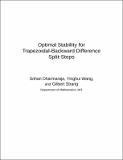Optimal stability for trapezoidal-backward difference split-steps
Author(s)
Dharmaraja, Sohan; Wang, Yinghui; Strang, Gilbert
DownloadStrang_Optimal stability.pdf (49.69Kb)
OPEN_ACCESS_POLICY
Open Access Policy
Creative Commons Attribution-Noncommercial-Share Alike
Terms of use
Metadata
Show full item recordAbstract
The marginal stability of the trapezoidal method makes it dangerous to use for highly non-linear oscillations. Damping is provided by backward differences. The split-step combination (αΔt trapezoidal, (1 – α)Δt for BDF2) retains second-order accuracy. The ‘magic choice’ a = 2 – √2 allows the same Jacobian for both steps, when Newton's method solves these implicit difference equations. That choice is known to give the smallest error constant, and we prove that a = 2 – √2 also gives the largest region of linearized stability.
Date issued
2009-09Department
Massachusetts Institute of Technology. Department of MathematicsJournal
IMA Journal of Numerical Analysis
Publisher
Oxford University Press
Citation
Dharmaraja, S., Y. Wang, and G. Strang. “Optimal stability for trapezoidal-backward difference split-steps.” IMA Journal of Numerical Analysis 30, no. 1 (January 21, 2010): 141-148.
Version: Author's final manuscript
ISSN
0272-4979
1464-3642